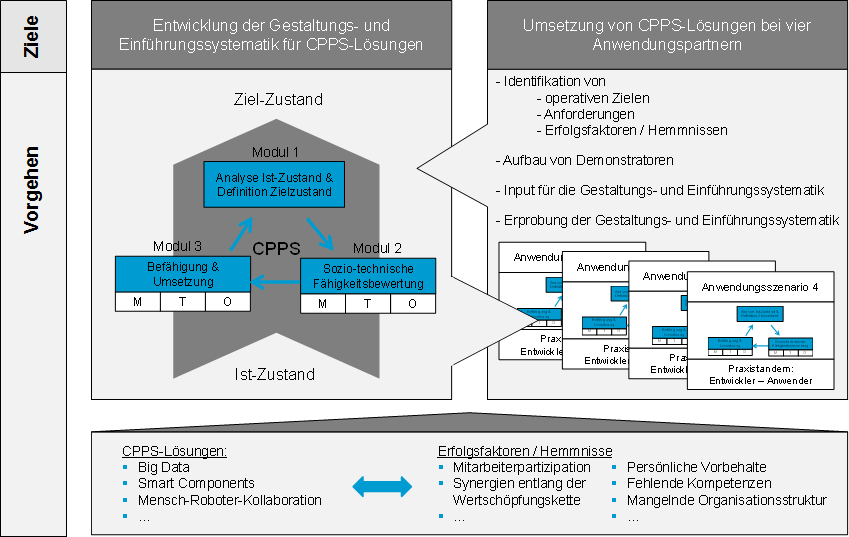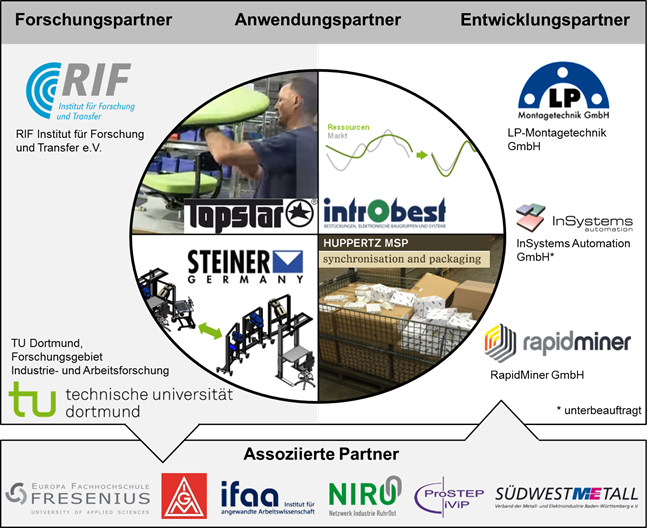STEPS
Socio-technical Design and Introduction of Cyber-Physical Production Systems in Non-R&D-Intensive Companies
(Project duration November 2015 to October 2018; project management by RIF e.V., Production Systems Department)
Problem
The increasing spread of information and communication technology (ICT), networked production units and new internet technologies enables many industrial companies to successfully introduce and operate cyber-physical production systems (CPPS). The importance of these CPPS for the future competitiveness of German industry is undisputed among computer scientists, engineering scientists as well as associations and political actors. These elements are summarised under the term "Industry 4.0". The general goal of this approach is to cope with growing flexibility requirements, increasing product individualisation, shorter product life cycles, increasing complexity of process flows, products and requirements as well as the challenges of demographic change in an automated, information-based and decentralised self-regulating manner.
Industrie 4.0-based production systems are designed to be self-controlling through the use of ICT, such as networked, embedded systems, and the introduction of monitoring and decision-making processes. Through their gradual implementation on the way to CPPS, further functional as well as economic potentials of existing production systems can be used. At the same time, it is undisputed that this will be accompanied by major changes in the design of work, technology and organisation in production, which will pose major challenges for small and medium-sized enterprises (SMEs) in particular. Limited management capacities as well as a lack of personnel and resources for research and development are bottlenecks for SMEs that should not be underestimated when introducing and implementing process innovations in general and CPPS solutions in particular. Against this backdrop, it is crucial to give these companies access to CPPS solutions and to enable them to use the new technologies in an economic and employee-oriented manner. Of particular relevance here is to overcome the socio-technical challenges in the introduction of Industrie 4.0 and to design, introduce and operate CPPS solutions in line with operational requirements.
Objective and Approach
In this context, the joint project STEPS has the overarching goal of developing a specific CPPS solution pattern for non-R&D-intensive SMEs as well as the strategies necessary for the introduction and implementation for an employee-oriented, economical production system.
This requires the development of a socio-technical design and implementation system for CPPS that targets the specific requirements of non-R&D-intensive enterprises. The design and implementation systematics should show SMEs suitable CPPS solutions that can be implemented to achieve the operational goals, taking into account the requirements and capabilities of socio-technical systems. Suitable organisational structures can promote a lasting process organisation and technology adaptability of the enterprises and lead to an increase in productivity as well as a reduction in the reaction time to varying customer requirements. The technical, work organisation and personnel challenges that arise in this process and their interdependencies are addressed at an early stage with the help of the systemic approach. This concept avoids asking only about the functioning of individual human-technology-organisation (H-T-O) components. Instead, the focus is on the interaction and combination of the three elements.
Parallel to the development of the design and implementation system, the exemplary further development of the socio-technical production systems of the application partners is being advanced by means of CPPS solutions. To this end, in field experiments, teams consisting of an application partner and development partners with corresponding expertise will develop concrete CPPS solutions for achieving specified operational goals in parallel with the development of the overall systematics and then implement them as demonstrators at the application partners. In the process, the overall system to be developed is validated and enriched by the experience gained. With the expertise in the consortium, demand-oriented solutions can be developed and implemented in the form of demonstrators in the central fields of action of the Industrie 4.0 initiative Big Data, Smart Components and Human-Robot Collaboration (HRC) in the sense of an individual and flexible type sharing between humans and robots.

Procedure and Division of Labour
The joint project is designed to run for three years. The desired research results will be developed in the form of six work packages. First, the state of the art and science will be processed. For this purpose, CPPS solutions will be catalogued and the effects on operative key figures and company goals will be examined. Based on this, an SME-oriented selection aid for CPPS solutions will be developed. Subsequently, success factors and obstacles in CPPS implementation are analysed on the basis of the introduction requirements on the part of SMEs and transferred into a taxonomy according to the HTO approach. Based on this preliminary work, a design and introduction system for CPPS solutions will be developed. In parallel, demonstrators will be implemented in the four application scenarios at the application partners with the support of the system developers. The experience gained will be specifically incorporated into the further development of the overall system. In addition to a project-accompanying validation of the overall system and the demonstrators with regard to their suitability for low-effort adaptation for other companies, there will also be a project-accompanying transfer of results.
For the successful implementation of the joint project, the division of labour between the partners is carried out according to their respective core competences. Based on the expertise of the development partners, the demonstrators to be developed come from the areas of big data, smart components and human-robot collaboration and are selected in a targeted manner according to the requirements and objectives of the application partners, implemented on site and the adaptability to other companies is ensured. The research partners develop and validate the overall system and accompany the industrial partners in the implementation and validation of the prototypes.

Research-, Development- and Application Partners
- TOPSTAR GmbH (consortium leader)
- RIF e.V. - Institute for Research and Transfer, Department of Industrial Engineering (coordinator)
- Dortmund University of Technology, Research Field Industrial and Labour Research
- InSystems Automation GmbH
- LP Assembly Technology GmbH
- RapidMiner GmbH
- intrObest GmbH & Co. KG
- MSP Material Synchronisation and Packaging GmbH
- Steiner-Optik GmbH
Funding Reference
This research and development project is funded by the Federal Ministry of Education and Research within the framework concept "Industry 4.0 - Research on the company hall floor" and is supervised by the Karlsruhe project management organisation. The responsibility for the content of this publication lies with the author.


![[Translate to English:] [Translate to English:]](/storages/zentraler_bilderpool/_processed_/2/6/csm_Altes_Maschinenbau-Gebaeude_6c4140c7ba.jpg)